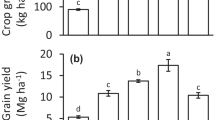Abstract
Plants of three wetland sedges, Carex vesicaria, C. rostrata, and C. gracilis, were subjected to flooding with diluted pig farm sewage water in a sand-culture experiment lasting for one growing season (20 weeks). Sewage water application altered growth dynamics and accumulation of dry matter in all three species; it shifted the distribution of dry matter in favor of above-ground parts; it depressed root growth both in dry mass and length; and it increased percentages of major nutrients (nitrogen, phosphorus, and potassium) in plant dry matter. In the root structure, sewage water application inhibited formation of gas spaces in the cortex, differentiation of exodermis and endodermis, and formation of starch grains in the cortex. The changes in root growth and structure are ascribed to the combination of (1) high nutrient availability, and (2) oxygen deficiency, which developed in the root medium following addition of sewage water. In view of these findings, Carex species are not well suited for use in the treatment of wastewaters rich in both mineral nutrients and organic matter.
Similar content being viewed by others
References
Armstrong, W. 1978. Root aeration in the wetland condition. In: Plant Life in Anaerobic Environments. pp. 269–297. Edited by D.D. Hook and R.M.M. Crawford. Ann Arbor Science Publishers, Ann Arbor, Michigan, USA.
Armstrong, W. and Beckett, P.M. 1987. Internal aeration and the development of stelar anoxia in submerged roots. New Phytol. 105: 221–245.
Bernard, J.M., Solander, D. and Květ, J. 1988. Production and nutrient dynamics in Carex wetlands. Aquat. But. 30: 125–147.
Brix, H. and Schierup, H.H. 1986. Root-zone Systems. Operational Experience of 14 Danish Systems in the Initial Phase. Report to the Environmental Protection Board. Aarhus University, Aarhus, Denmark.
Brix, H. and Schierup, H.H. 1989. The use of aquatic macrophytes in water-pollution control. Ambio 18: 100–107.
Brix, H. and Schierup, H.H. 1990. Soil oxygenation in constructed reed beds: the role of macrophyte and soil-atmosphere interface oxygen transport. In: Constructed Wetlands in Water Pollution Control. pp. 53–66. Edited by P.F. Cooper and B.C. Findlater. Pergamon Press, Oxford, England.
Findlater, B.C., Hobson, J.A., and Cooper, P.F. 1990. Reed bed treatment systems: performance evaluation. In: Constructed Wetlands in Water Pollution Control. pp. 193–204. Edited by P.F. Cooper and B.C. Findlater. Pergamon Press, Oxford, England.
Gries, C., Kappen, L. and Lösch, R. 1990. Mechanism of flood tolerance in reed, Phragmites australis (Cav.) Trin. ex Steudel. New Phytol. 114: 589–593.
Javorský, J. 1982. Chemical Analyses in Agricultural Laboratories (In Czech). Czech Ministry of Agriculture, Praha, Czechoslovakia.
Jeník, J. and Květ, J. 1983. Ecological Study of Inundated Ecosystems near Tŕeboň, South Bohemia, Czechoslovakia. The ‘Wet Meadows’ Study Site (In Czech with English summary). Academia, Praha, Czechoslovakia.
Justin, S.H.F.W. and Armstrong, W. 1987. The anatomical characteristics of roots and plant response to soil flooding. New Phytol. 106: 465–495.
Končalová, H. 1990. Anatomical adaption to waterlogging in roots of wetland graminoids: limitations and drawbacks. Aquat. Bot. 38: 127–134.
Končalová, H. and Pazourek, J. 1987. Root dimorphism in flooded Carex gracilis Curt. Acta Universitatis Carolinae Biologica 31: 43–50.
Konings, H. 1982. Ethylene-promoted formation of aerenchyma in seedling roots of Zea mays L. under aerated and non-aerated conditions. Physiol. Plant. 54: 119–124.
Kubica, S. 1987. Determination of the ratio between stele and cortex tissue in maize roots cultivated under over-supply of nitrate. In: Abstracts 3rd Int. Symp. ‘Structure and Function of Roots’, Nitra, Czechoslovakia. August 3–7, 1987.
Kutschera, L. and Lichtenegger, E. 1982. Wurzelatlas Mitteleuropäischer Grundpflanzen. I. Monocotyledonae. Gustav Fischer Verlag, Stuttgart, Germany.
Květ, J., Ondok, J.P., Nečas, J. and Jarvis, P.G. 1971. Methods of growth analysis. In: Plant Photosynthetic Production. Manual of Methods. pp. 343–391. Edited by A. Šesták, J. Čatský, and P.G. Jarvis. Dr. W. Junk Publishers, The Hague.
Marschner, H. 1983. General introduction to the mineral nutrition of plants. In: Inorganic Plant Nutrition. Encyclopedia of Plant Physiology, New Series, 15 A. pp. 5–60. Edited by A. Lauchli and R.L. Bieleski. Springer Verlag, Berlin, Germany.
Mendelssohn, I.A., McKee, K.L. and Postek, M.T. 1982. Sublethal stresses controlling Spartina alterniflora productivity. In: Wetlands: Ecology and Management. pp. 223–242. Edited by B. Gopal, R.E. Turner, R.G. Wetzel and D.F. Whigham. National Institute of Ecology and International Scientific Publications, Jaipur, India.
Moorby, J. and Besford, R.T. 1983. Mineral nutrition and growth. In: Inorganic Plant Nutrition. Encyclopedia of Plant Physiology, New Series, 15 b. pp. 481–527. Edited by A. Lauchli and R.L. Bieleski. Springer Verlag, Berlin, Germany.
Ponnamperuma, F.N. 1984. Effects of flooding on soils. In: Flooding and Plant Growth. pp. 10–46. Edited by T.T. Kozlowski. Academic Press, Orlando, Florida, USA.
Reddy, K.R. and Smith, W.H. 1987. Aquatic Plants for Water Treatment and Resource Recovery. Magnolia, Orlando, Florida, USA.
Schierup, H.H., Brix, H. and Lorenzen, B. 1990. Wastewater treatment in constructed reed beds in Denmark-state of the art. In: Constructed Wetlands in Water Pollution Control. pp. 495–504. Edited by P.F. Cooper and B.C. Findlater. Pergamon Press, Oxford, England.
Sojka, R.E. 1988. Measurement of root porosity (volume of root air space). Environmental and Experimental Botany 28: 275–280.
Soukupová, L. 1986. Study of life strategies in marshlands graminoids (In Czech). PhD Thesis, Botanical Institute, Czechoslovak Academy of Sciences, Třeboň, Czechoslavakia.
Stephenson, M., Turner, G., Pope, P., Colt, J., Knight, A., and Tchobanoglous, G. 1980. The Use and Potential of Aquatic Species for Wastewater Treatment. Publication No. 65 Appendix A, The Environmental Requirements of Aquatic Plants. California State Water Resources Control Board, Sacramento, California, USA.
Tadano, T. and Yoshida, S. 1978. Chemical changes in submerged soils and their effect on rice growth. In: Soils and Rice. pp. 400–420. Int. Rice Res. Inst., Los Banos, Philippines.
Author information
Authors and Affiliations
Rights and permissions
About this article
Cite this article
Končalová, H., Květ, J., Pokorný, J. et al. Effect of flooding with sewage water on three wetland sedges. Wetlands Ecol Manage 2, 199–211 (1993). https://doi.org/10.1007/BF00188154
Issue Date:
DOI: https://doi.org/10.1007/BF00188154




